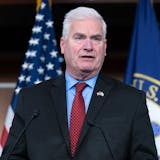Target's shelves are better stocked than ever before. It has added thousands of new grocery items. And it has rolled out new offerings such as the jazzy in-house Cat & Jack kids clothing line.
So why haven't shoppers visited Target Corp.'s stores in the last few months as they have in the past?
That was the troubling question on analysts' minds after the Minneapolis-based retailer reported a surprising 2.2-percent drop in traffic during the May-to-July period — its first decline in that metric in a year and a half, and the biggest slide it's seen since the Great Recession outside of the massive data breach a few years ago.
The company's shares tumbled in trading Wednesday as Target also reported its first comparable U.S. sales drop in two years and lowered its forecast for the second half of the year, including during the holidays, when it now expects sales to be flat to down 2 percent.
It was a stark change from several months ago when Target executives said sales could grow as much as 2.5 percent this year.
The stock closed Wednesday at $70.63, down $4.85 or 6.4 percent.
Target executives offered their own explanations for the falloff in traffic: They lost some trips to in-store pharmacies amid the rebranding of them to the CVS Health banner. Electronics sales were down double digits — Apple products in particular slumped more than 20 percent. And an overhaul of the grocery department to include more specialty and organic items is still not hitting the mark with consumers.
But analysts also wondered if there were deeper issues at play — in particular, Target's ability to hold off the mounting threat from Amazon.com.

